Curly lilac: varieties, care, reproduction and use of the plant
Curly lilac has many names, such as hyacinth bean or dolichos. It belongs to the legume family. This plant can be either an annual or a perennial herb. You can meet dolichos in Africa, it is from this hot continent that the seeds of climbing lilacs came to the countries of Europe and Asia.
Content:
- Plant characteristic
- Lilac varieties
- Curly lilac care
- Reproduction of curly lilac
- The use of curly lilac
Plant characteristic
In appearance, the Hyacinth bean is a vine that can be up to 6 meters long. The plant perfectly wraps around any support, creating a wonderful composition of flowers and fruits.
Description of lilac:
- The stems are herbaceous, curly, have a bright reddish-lilac color.
- The leaves are large and have a symmetrical heart-shaped shape.
- Flowers are collected in bunches, the color of which depends on the type of plant.
- The lifespan of one brush is from 10 to 20 days, one flower on it blooms and withers within 3 days.
With proper care, curly lilacs will delight with their flowering all summer and autumn until the first frost.
The maroon-colored beans also look very impressive, especially against the dark green foliage. Fruit ripening in different varieties in a different period from 2.5 to 7 months. Each bean can contain up to 5 seeds, which look nothing like any other bean. Their color can be cream, black or beige, and all of them always have a white edging.
Lilac varieties
In nature, there are many varieties of curly lilacs, but they all grow in Africa or Asia. In cooler conditions, only a few of them take root.
But they also have a variety of colors, thanks to which you can combine varieties and get a more effective decoration of a summer cottage or land near the house. Cultivars can be classic purple, also white, pink and red.
There are hybrids that produce inflorescences in two different colors.
Ruby Moon .:
- This variety has strong thick branches and large clusters-inflorescences.
- The color of the flowers is purple.
- The leaves are painted in a dark green tone and a reddish tint.
- The flowers have a pleasant aroma.
- The bush tolerates hot, dry weather very well.
- Keeps well cut in water.
- Annual.
Lilac cascade:
- The stems of this plant are highly branched, on one plant there can be up to 30 shoots, the leaves on them are densely located. Therefore, this variety is recommended for braiding arbors or awnings.
- The length of the branches is 5 meters, the bush itself expands to 60 cm.
- Annual.
Purple garland:
- This variety is suitable for creating cut compositions, as it stays fresh for a long time.
- The branches stretch up to 3-4 meters.
- Leaves are heart-shaped with a red tint and clearly visible veins.
- Fruits are purple, curved, up to 6 cm long.
- Annual.
Curly lilac care
Caring for climbing lilacs is not difficult, and planting it is not much different from growing any legumes. Dolichos is a moisture-loving plant and watering should be taken with special responsibility. Do not let the soil dry out at the plant.On hot summer days, watering should be a daily ritual. It is worth periodically loosen the soil around the bush and remove weeds.
It is also necessary to regularly feed the plant with fertilizers containing potassium.
With a lack of this element, yellow spots appear on the leaves. Curly lilacs are resistant to diseases and pests, which makes it much easier to care for. It also has a beneficial effect on the fruits that can and even need to be eaten.
Reproduction of curly lilac
Climbing lilacs reproduce with the help of seeds. This is the easiest and most obvious way. To plant beans for seedlings, you need choose an early spring month, so that the plants have enough time to grow and get stronger before planting in open ground.
Growing tricks:
- Before planting seeds, they must be soaked in water.
- After a while, when the beans hatch, they can be planted each in a separate small pot.
- It is necessary to deepen it no more than 3 cm into the prepared soil.
- The pots must be kept in a place where the ambient temperature will not drop below 22 degrees.
- When the plant shows its first three leaves, it must be pinched. Thanks to this, the dolichos will have more branches.
- For planting in open ground, it is worth waiting for the end of the spring frost.
- The place is chosen well-lit, with fertile soil, windless.
- With the wrong choice of place, the curly lilac will bloom very poorly, or, in general, may not release flowers.
- It is also worth installing supports if there are none.
It is recommended to get a young plant out of the pot carefully and together with an earthen lump. The roots of the curly lilac are very fragile, and if handled carelessly, they may not take root. The distance between the bushes should be at least 0.5 meters.
When the plant gets stronger, and the branches stretch 20-30 cm, it can be piled up, and the shoots can be tied to supports or braided.
With the further growth of the stems of curly lilacs, their need to guide and tie... If you ignore these actions, branches can fall to the ground, break or braid a nearby plant.
At the end of the season, you need to collect seeds for planting the next year. Since the curly lilac is not frost-resistant in cold regions, it is an annual. For these purposes, beans are selected that were formed earlier than anyone else. This is due to the fact that for them the bush gave the most strength and nutrition, therefore, they will germinate perfectly next year. And also create a healthy strong bush. After harvesting, the seeds should be dried for 2-3 days to avoid spoilage and decay.
The use of curly lilac
Curly lilacs found wide application in landscape design... It perfectly wraps around any supports and grows very quickly. Therefore, as a decoration for a gazebo, or creating a shade canopy, and for vertical gardening, this plant is perfect. The big advantage of dolichos is that the flowering period, starting in the month of July, can be very long. Spectacular flowers will constantly decorate the area.
You can combine climbing lilacs with almost any plant, even with vines.
Also, this plant thrives and develops in pots, therefore it is often used as a balcony gardener. By tying up and directing the branches in the right direction in time, you can get a beautiful green garden outside the window in the city.
Curly lilac is not only an ornamental plant, its fruits are used in cooking:
- Beans taste great and contain many nutrients. Thus, the protein content is 28% and 60% carbohydrates. They also contain vegetable fats and minerals.
- Both ripe beans and green pods are prepared. Many recipes came to European countries from Africa, and were modernized in a local way.
- They can be used for the same purposes as common beans and beans: added to soups and salads, or to prepare individual meals.
Also, the fruits of dolichos are used for medical purposes. From them, plant agglutinin is obtained, which is used to determine the blood group.
More information can be found in the video.



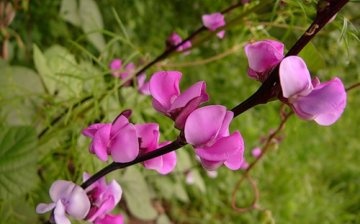
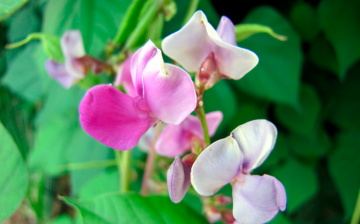
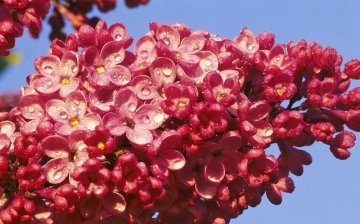









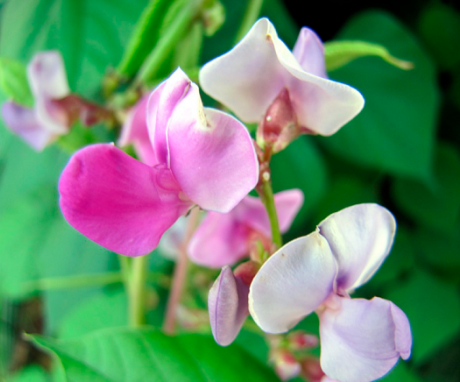
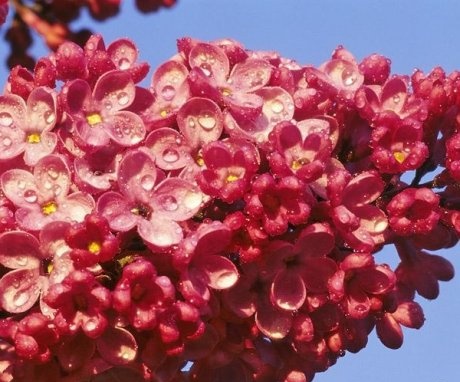
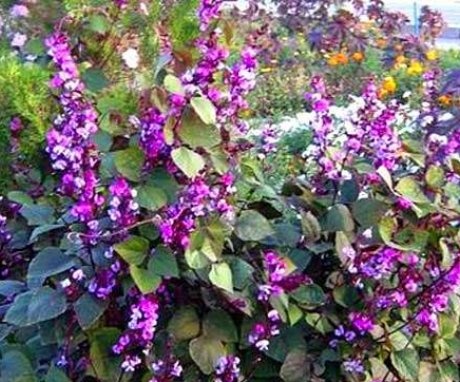


In general, we call this curly lilac ornamental beans, and, in principle, it is a leguminous plant more than a shrub like a lilac.